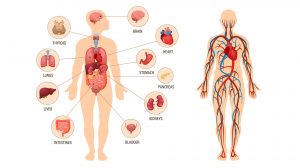Table of Contents
Definition
noun
plural: isomaltoses
i·so·mal·tose, aɪsoʊˈmɔːltəʊz
A disaccharide formed from the combination of two glucose monomers together via α(1→6) glycosidic bond; an isomer of maltose
Details
Overview
Carbohydrates are a major class of biomolecules that can be classified based on the saccharide constituents. A disaccharide is a carbohydrate made up of two monosaccharides that are linked together by a glycosidic bond (glycosidic linkage). Isomaltose is an example of a disaccharide carbohydrate.
Properties of isomaltose
Isomaltose is a disaccharide with a chemical formula of C12H22O11 and it is comprised of two glucose units. It has a molar mass of 342.30 g·mol−1. Its melting point is 98-160 °C. It is soluble in water and a fermentable sugar.
Isomaltose vs. Maltose
Isomaltose is an isomer of maltose. The difference between isomaltose and maltose is the glycosidic linkage that joins two glucose units. In maltose, the glucose molecules are linked together by an α-1→4 glycosidic bond. In isomaltose, the linkage is an α-1→6 glycosidic bond. This means that in maltose the bond forms between the α-anomeric form of Carbon-1 (C-1) on one glucose and the hydroxyl oxygen atom on C-4 on the other glucose whereas in isomaltose the bond is between C-1 of one glucose and C-6 of the other. Similar to maltose, the isomaltose is a reducing sugar. Since it has only one of the two anomeric carbons in the glycosidic bond, it can turn into an open-chain form with its functional group acting as a reducing agent.
Isomaltose vs. Isomaltulose
Isomaltose and isomaltulose are both disaccharide carbohydrates. Isomaltose is a disaccharide derived from maltose whereas isomaltulose is from sucrose. Sucrose is one of the common dietary disaccharides. Its isomer is isomaltulose, which like sucrose is composed of glucose and fructose linked together by an α-1→6 glycosidic bond. Thus, isomaltose and isomaltulose have a similar glycosidic bond that connects two monosaccharide constituents. In isomaltose, however, the two monosaccharides are two glucose units. Isomaltose should not also be confused with isomalt. Isomalt is a disaccharide polyol from sucrose. It can be produced when isomaltulose is hydrogenated.
Biological activities
Isomaltose is one of the main constituents in isomalto-oligosaccharide (IMO). The others are isomaltotriose, isomaltotetraose, isomaltopentaose, panose, kojibiose, etc. These carbohydrates are linked together by an alpha-D-(1,6)-linkages to form IMO. IMO is produced naturally in fermented foods, e.g. soy sauce and sake. Isomaltose may also be obtained from the digestion of starch, such as bread, rice, potatoes, etc. In humans, dietary isomaltose and IMO are not easily digested. The alpha-(1,6)-linkages are not as easily hydrolyzed as the alpha-(1,4)-linkages. The glucosidase enzyme sucrase-isomaltase helps cleave the alpha 1-6 linkages through hydrolysis. The enzyme is located on the brush border of the small intestine. It aids in the digestion of not just isomaltose but also of sucrose and starch. Thus, the deficiency of this enzyme could lead to indigestion and osmotic diarrhea.
Biological function and importance
Isomaltose is a disaccharide comprised of glucose, which can be metabolized to produce chemical energy. Thus, isomaltose can serve as a source of energy. It may be obtained from the digestion of starch or food containing IMO or isomaltose. Most of the dietary isomaltose, though, is not obtained naturally. Rather, it is made available from artificial preparations. For instance, it is produced artificially from high maltose syrup through the enzyme transglucosidase. Another way is from sucrose through the bacterial enzyme sucrose isomerase.1. The artificially-made isomaltose is used as a sweetening agent in confections, candies, and canned foods. Apart from the food industry, artificial isomaltose is also used in animal feed, medicines, and cosmetics.
Metabolic disorders
Congenital Sucrase-Isomaltase deficiency is a rare metabolic disorder characterized by the inability of the individual to digest certain sugars due to a deficiency of sucrase-isomaltase. Without this enzyme, isomaltose, isomaltulose, and sucrose are unabsorbed and thereby act as osmotic laxatives. The common symptoms include diarrhea, vomiting, flatulence, and abdominal distention. Diagnosis is often done by hydrogen breath test or by a biopsy from the small intestine for a disaccharide assay. Genetic testing may also be done. The condition is associated with mutations in the SI gene. This gene codes for a functional enzyme sucrase-isomaltase. The mutation of this gene might have resulted in the impairment of the enzyme’s structure, function, or production. The condition is inherited in an autosomal recessive pattern.2 Management of sucrase-isomaltasse deficiency entails a modification of the diet by alleviating the consumption of starch or sucrose.
Supplementary
Etymology
- Ancient Greek ἴσος (ísos, meaning “equal”) +malt + –ose (a suffix used in chemical naming of sugars)
IUPAC
Chemical formula
- C12H22O11
Synonym(s)
Further reading
See also
- disaccharide
- carbohydrate
- glucose
- maltose
Reference
- Isomaltulose Calories, Foods, Benefits, Dangers. (2017, January 6). Retrieved from ://www.nutrientsreview.com/carbs/disaccharides-isomaltose.html Link
- Genetics Home Reference. (2002, January 1). Congenital sucrase-isomaltase deficiency. Retrieved from ://ghr.nlm.nih.gov/condition/congenital-sucrase-isomaltase-deficiency#inheritance Link
© Biology Online. Content provided and moderated by Biology Online Editors







